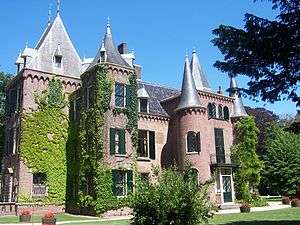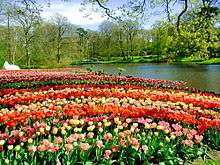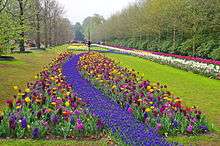Keukenhof
Keukenhof (English: "Kitchen garden"; Dutch pronunciation: [ˈkøːkə(n)ˌɦɔf]), also known as the Garden of Europe,[1] is one of the world's largest flower gardens, situated in the town of Lisse, in the Netherlands. According to the official website, Keukenhof Park covers an area of 32 hectares (79 acres) and approximately 7 million flower bulbs are planted in the gardens annually.[2][3] Keukenhof is widely known for its tulips, it also features numerous other flowers, including hyacinths, daffodils, lilies, roses, carnations and irises.[4]
| Keukenhof | |
|---|---|
Tulips at the Keukenhof in 2009 | |
  | |
| Location | Lisse, Netherlands |
| Nearest city | Haarlem |
| Coordinates | 52.271256°N 4.546365°E |
| Established | 1949 |
| Owned by | Stichting Graaf Carel van Lynden |
| Visitors | 1500000 (in 2019) |
| Collections | tulip, orchid |
| Website | www |

Keukenhof is located in the province of South Holland, south of Haarlem and southwest of Amsterdam in the area called the "Dune and Bulb Region" (Duin- en Bollenstreek). It is accessible by bus from Haarlem and Leiden train stations as well as Schiphol.
Though its grounds are open year-round for private affairs and festivals, Keukenhof is only open to the general public for a world-renown 8 week tulip display from mid-March to mid-May,[5] with peak viewing arriving near mid-April, depending on growing season weather, which varies annually. In 2019, 1.5 million people visited Keukenhof,[6] equivalent to 26,000 visitors per day.[7] By comparison, the Rijksmuseum receives an average of 8000 visitors per day, the Efteling receives 14,000.
History
Keukenhof is situated on the 15th-century hunting grounds of Slot Teylingen, and was the castle's kitchen garden (in Dutch: keukentuin), providing game, fruit and vegetables. The most noted inhabitant, and beneficiary of the garden was Countess Jacoba van Beieren (1401-1436).[8] In 1638, the estate was purchased by Adriaen Maertensz Block, captain and governor of the VOC. In 1641 he had a large manor house constructed, which he named Keukenhof, now known as Castle Keukenhof.[9][10]
In 1857, Baron and Baroness Van Pallandt, at the time owners of the estate, tasked landscape architect Jan David Zocher and his son Louis Paul Zocher, both also designers of Amsterdam's Vondelpark, to restructure the park and grounds around the castle. Those parks, designed in English style, remain the foundations for the gardens.[11][12]
Keukenhof, the park as it is now known, was established in 1949 by a consortium of bulb growers and flower exporters to showcase their products and support the export industry. The garden opened to the public in 1950 and received 200,000 visitors in its first year.[13] It operates under a charitable foundation of Count Carel De Gaaf van Lynden.
Gardens


Each fall, 40 gardeners plant the 7 million bulbs, donated to the park by over 100 growers.[14] Planting starts early October and is usually completed by December 5th, around Sinterklaas.[15] The flowerbeds are synchronized to the different bulb flowerings to ensure blooms throughout the duration of park's 8-week opening.[16] To ensure continuous bloom, three bulbs are planted in each location. The shallowest bulb will bloom first for three weeks, followed by the subsequent layers.[17]
In addition to the tulip gardens, Keukenhof features a variety of other gardens. The English landscape garden features winding paths and surprise see-through vistas. The walled area of the historical features archival varieties. In the Nature Garden shrubs and perennials are combined with bulb plants. The Japanese Country Garden is a non-traditional garden in a natural environment.[14] Four pavilions house rotating displays and flower exhibits.
Opening times
The grounds of Castle Keukenhof[18] are open all year long and are frequently used for festivals such as Castlefest, the Ladies Winternight,[19] and the Christmas Fair.[20] The castle also hosts classical music concerts.
Visitors
In 2017, Keukenhof received 1.4 million visitors.[21] 20% of the visitors are Dutch, while 40% are from Germany, UK and Belgium. The number of visitors from the USA (10%) and China (8%) has grown over the years.
| Year | Visitors | Year | Visitors | |
|---|---|---|---|---|
| 2008 | 835,000 | 2014 | 1,020,000 | |
| 2009 | 850,000 | 2015 | 1,175,000 | |
| 2010 | 800,000 | 2016 | 1,143,000 | |
| 2011 | 884,000 | 2017 | 1,400,000[22] | |
| 2012 | 875,000 | 2018 | 1,400,000[23] | |
| 2013 | 849,000 | 2019 | 1,500,000[24] |
Visitor breakdown by nationality for 2019 season:[25][26]
| Country | % visitors |
|---|---|
| the Netherlands | 20% |
| Germany | 15% |
| United States | 10% |
| France | |
| UK | |
| Chinese | 4% |
Governance
Keukenhof falls under a charitable foundation of Count Carel De Gaaf van Lynden (Stichting Graaf Carel van Lynden). As of January 1, 2016, the foundation owns both Keukenhof and Castle Keukenhof plus the surrounding estate.[27]
Revenues
The Keukenhof does not receive government subsidies; revenues are generated from ticket sales and the food and beverage licensees on premise. In 2019 Keukenhof generated €25 million in revenue.[28] In 2020, as a consequence of the 2019-20 coronavirus pandemic, and closures to contain it, the park was shut from its scheduled opening day, 21 March until its scheduled closing date, 10 May, costing it an estimated $25 million in revenues.[29]
See also
- National Tulip Day, opening of the tulip season in Amsterdam (January).
References
- "The 'Garden of Europe' is in full bloom in The Netherlands". ABC News. ABC News Internet Ventures. April 30, 2018. Retrieved September 27, 2019.
- Keukenhof website - About Archived 2015-02-19 at the Wayback Machine
- 5 facts and figures keukenhof.nl (in English)
- "Keukenhof". Visit Holland. Dutch Tourism Board. Retrieved October 7, 2019.
- Keukenhof FAQs: When is Keukenhof open?
- "Visitor numbers to the Keukenhof in the Netherlands". Statistista.com. Statista. Retrieved 19 September 2019.
- (in Dutch)"De Bloemen van de Keukenhof hebben geen marketing nodig". De Volkskrant. DPG Media. Retrieved 8 October 2019.
- Tinsley, Claire. "The Greatest Flower Show on Earth: The History of the Keukenhof". Smithsonian Journeys. Smithsonian Journeys. Retrieved 19 September 2019.
- (in Dutch) Landgoed Keukenhof Archived September 11, 2011, at the Wayback Machine, Buitenplaatseninnederland.nl
- "GESCHIEDENIS VAN DE KEUKENHOF". Is Geschiedenis. Pepijn Dobbelaer. Retrieved 29 September 2019.
- (in Dutch)"Historie van de Keukenhof". Anton Nijssen. Anton Nijssen. Retrieved 19 September 2019.
- Keukenhof website - History. Archived.
- (in Dutch)"Geschiedenis van de Keukenhof". Is Geschiedenis. Virtumedia BV. Retrieved 19 September 2019.
- "Presentation". Keukenhof. Keukenhof. Retrieved 7 October 2019.
- "Plantseizoen Keukenhof van start: zeven miljoen bloembollen de grond in". Omroep West (in Dutch). Retrieved 2019-10-08.
- "Visit Keukenhof Tulip and Flower Gardens, South Holland". European Traveller. Retrieved 8 October 2019.
- (in Dutch)"Plantseizoen Keukenhof van start: zeven miljoen bloembollen de grond in". Omroep West. Omroep West. 2 October 2018. Retrieved 7 October 2019.
- Castle Keukenhof website Archived 2011-03-04 at the Wayback Machine
- (in Dutch) Ladies Winternight Keukenhof
- Christmas Fair Archived 2013-02-22 at Archive.today
- (in Dutch) Keukenhof sluit topseizoen Archived 2018-01-10 at the Wayback Machine press release www.keukenhof.nl
- "Keukenhof- Visitors 2018". Van Doorne. Retrieved 8 October 2019.
- "Number of visitors to the Keukenhof in the Netherlands from 2011 to 2019 (in 1,000s)". Statista. Statista. Retrieved 8 October 2019.
- "Number of visitors to the Keukenhof in the Netherlands from 2011 to 2019 (in 1,000s)". Statista. Statista. Retrieved 8 October 2019.
- Klopper, Roy (20 May 2019). "Record: 1,5 miljoen bezoekers Keukenhof". De Telegraaf. Retrieved 8 October 2019.
- "Keukenhof sluit een succesvol seizoen | Keukenhof.nl". keukenhof.nl. Retrieved 2019-10-08.
- "Fusie Keukenhof is bekrachtigd". www.bpnieuws.nl (in Dutch). Retrieved 2019-10-08.
- Reijn, Gerard (17 March 2019). "De bloemen van de keukenhof hebben geen marketing nodig". De Volkskrant. Retrieved 8 October 2019.
- Siegal, Nina (12 April 2020). "Where Have 140 Million Dutch Tulips Gone? Crushed by the Coronavirus". The New York Times. Retrieved 12 April 2020.
External links
| Wikimedia Commons has media related to Keukenhof. |
